TIMELINE
Background: Warsaw Ghetto uprising, April-May 1943.
US Holocaust Memorial Museum, courtesy of Louis Gonda
1933–1938
Map
Nazi Germany

By early 1939, Nazi Germany had annexed Austria and the Czech lands (view larger map in a new tab).
With Adolf Hitler and the Nazis’ rise to power in 1933, hatred of Jews became government policy in Germany. Many Germans believed that Jews threatened a supposedly superior “Aryan race.” They strongly supported measures that excluded Jews from society and aimed to expel them from Germany. Other Germans did not hate Jews but came to accept the regime’s extreme policies. Some saw the policies as a chance to advance their careers or faced pressure to conform at work or in their communities. The Nazis’ success in improving the economy and expanding Germany’s borders also helped Germans to accept attacks on Jews.
January 30, 1933
Hitler Named German Chancellor

Adolf Hitler greets the participants in a torchlight parade on the evening of his appointment as chancellor of Germany. US Holocaust Memorial Museum, courtesy of National Archives and Records Administration
Adolf Hitler and the Nazi Party took control of the German government. After years of crisis and unrest, many Germans had lost faith in democracy. The idea that a “strong leader” could bring stability to the country helped the Nazis rise to power.
Jacob Wiener, a Jewish German boy living in Bremen, noticed only gradual changes in the first years after 1933. Fewer non-Jewish customers came to his father’s bike shop, his neighbors grew less friendly, and his friends and classmates joined Nazi youth organizations.
March 22, 1933
Nazi Germany Opens Dachau Concentration Camp
Shortly after the Nazis came to power, they opened the Dachau concentration camp. Dachau and other camps held political prisoners and people whom Nazi ideology marked as threats to the German nation, including Jews, Roma (“Gypsies”), gay men, and others
April 1, 1933
Nazi Boycott of Jewish-Owned Businesses Begins
The boycott was an attempt to encourage ordinary Germans to exclude Jews from the German economy. Although the boycott ended in failure, the Nazi government soon found more effective means of excluding and persecuting Jews in Germany.
April 1933
First Anti-Jewish Laws in Germany Pass
Nazis sought to exclude Jews from all aspects of German public life. In 1933, the regime passed a law barring Jewish people from working in government offices and the civil service. The government also limited the number of Jews permitted to attend German public schools.
September 15, 1935
Nuremberg Race Laws Are Issued
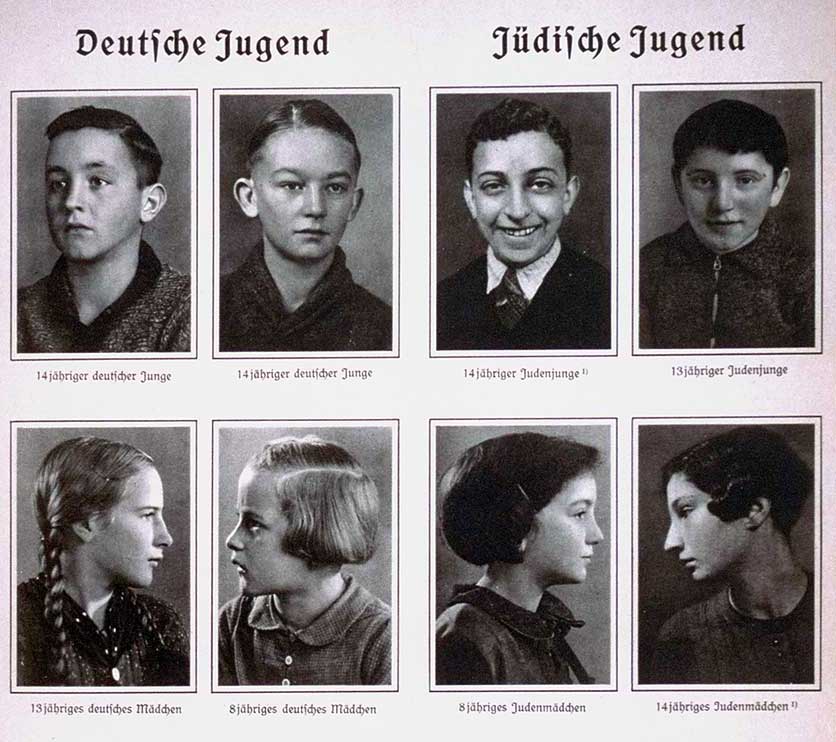
Part of a classroom chart titled “German Youth, Jewish Youth” published in a Nazi-era textbook on “race science.” US Holocaust Memorial Museum, courtesy of Library of Congress
March 13, 1938
Germany Annexes Austria

After a Nazi Party conference in Nuremberg, the German government issued a set of “race laws.” These laws sought to protect the so-called purity of “German blood.” The laws defined Jews as a race and stripped them of German citizenship. They also limited Jews’ rights and marked them for discrimination and persecution.
The Nuremberg laws encouraged German teachers to include Nazi racism in their lessons. Even grade school students were taught the racist myth that “Aryans” were superior to Jews and other groups.
Hitler Youth humiliate Jews by forcing them to clean city streets in Vienna, March–April 1938. Yad Vashem
German troops occupied Austria and incorporated it into the German Reich. A wave of mass violence against Jews in Austria followed the annexation.
Many ordinary people joined in the violence against Austrian Jews. Teenagers in the Hitler Youth took a leading role in terrorizing their Jewish neighbors.
October 1, 1938
Czechoslovakia Is Forced to Cede Territory to Germany
Germany annexed borderland from Czechoslovakia as part of a pact imposed by European powers. Signed in Munich, the pact was a victory in Hitler’s drive to expand Germany and unite Germans in one state. Most leaders, hoping to avoid a war, did little to resist Hitler’s aggression.
November 9–10, 1938
Jews in Germany Targeted on Kristallnacht (“The Night of Broken Glass”)

Hitler Youth humiliate Jews by forcing them to clean city streets in Vienna, March–April 1938. Yad Vashem
Nazi leaders organized a wave of attacks on Jews in Germany. Some civilians joined Nazi paramilitaries to loot businesses owned by Jews and burn synagogues. Many Jews were arrested and sent to camps. The Nazis hoped that violence would drive Jews out of Germany.
German police at all levels joined anti-Jewish actions during Kristallnacht. They arrested Jews on the orders of officials. After Nazi paramilitaries set fire to synagogues, local firefighters refused to put the fires out.
Fall 1938
“Legal” Persecution of Jews Accelerates

Cup and saucer from the Linhards’ cafe, brought to the United States by the family in 1939. US Holocaust Memorial Museum, gift of Steven and Marion Linhard
After Kristallnacht, the Nazi regime issued laws forcing Jews to turn their businesses and assets over to non-Jews. Jews were barred from attending public schools in Germany. Other laws forbade them from owning or driving a car, or even visiting a movie theater.
Business owner Bernhard Linhard ran a successful cafe in Vienna. Under the Nazi regime’s 1938 laws, Bernhard lost the business and his family faced financial ruin.
German police at all levels joined anti-Jewish actions during Kristallnacht. They arrested Jews on the orders of officials. After Nazi paramilitaries set fire to synagogues, local firefighters refused to put the fires out.
December 2, 1938
First Kindertransport Arrives in the United Kingdom
Many Jews in Germany attempted to leave the country after Kristallnacht. Most governments refused to accept Jewish refugees. Some countries, such as the United Kingdom, admitted a limited number. The United Kingdom accepted 10,000 German Jewish children during the “Children’s Transport” in 1938–1940.
1939–1941
Map
Occupied Eastern Europe
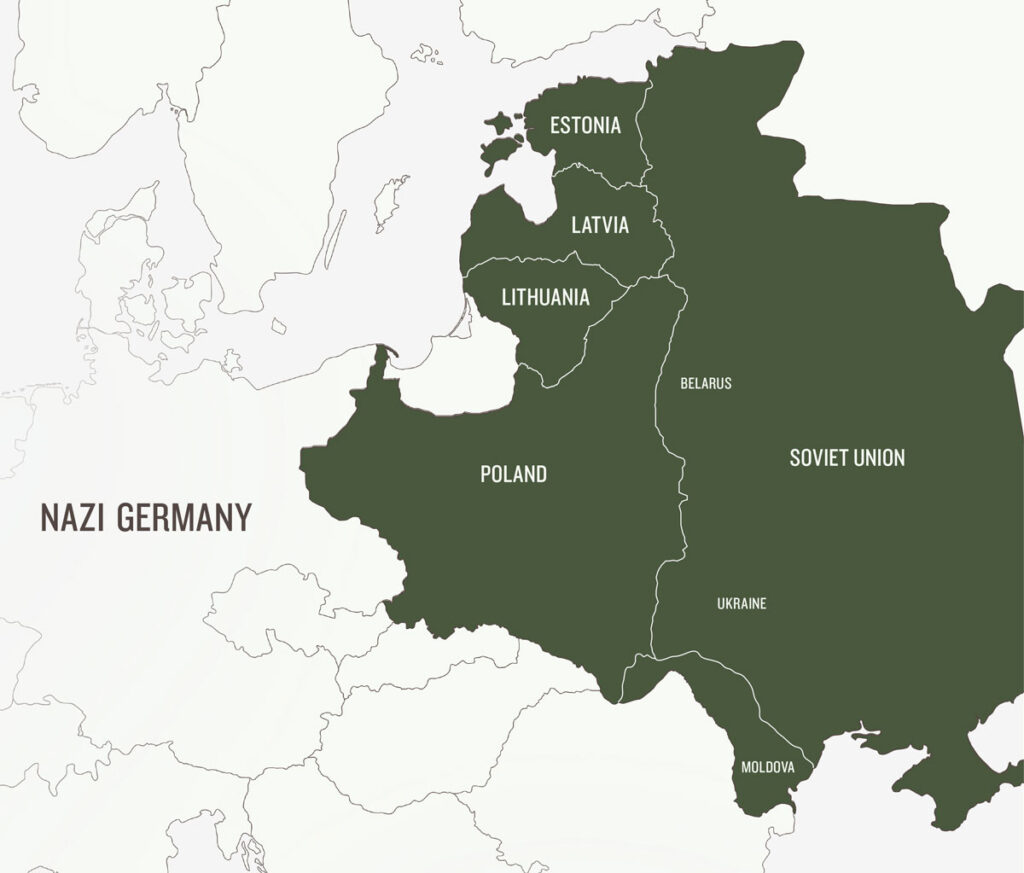
Nazi Germany invaded Poland and the Soviet Union. The Nazi regime aimed to secure “living space” for Germans and dominate people they regarded as “inferior” (view larger map in a new tab).
Nazi Germany invaded Poland in 1939 and the Soviet Union in 1941. The German occupiers murdered Jews in mass shootings and deported them to ghettos, camps, and killing centers. As Nazi leaders finalized plans to murder all European Jews in late 1941, they increasingly relied on local residents to help capture and kill the victims. Authorities encouraged violence against Jews in local communities. Some people were motivated by hatred to target Jews. Most weighed a variety factors, including:
- Opportunities for employment and food
- Potential profit in exploiting Jewish people or looting property
- Desire to settle scores against Jewish people for perceived wrongs
- Eagerness to gain the favor of authorities
September 1, 1939
Germany Invades Poland, and World War II Begins

German troops and Polish civilians stop on a bridge on the outskirts of Warsaw, as smoke rises from the burning city. US Holocaust Memorial Museum, courtesy of National Archives and Records Administration
After the German invasion of Poland, Great Britain and France declared war on Germany. Germany defeated Poland within a month. Nazi authorities introduced brutal policies to insulate Germans from other “races” there. These policies targeted both non-Jewish Poles and Polish Jews.
Police from Germany served in occupied Poland. Officials instructed them to use extreme violence against “racial enemies.” Nazi propaganda further encouraged them to act with brutality.
September 17, 1939
Soviet Union Invades Eastern Poland
As part of a treaty with Nazi Germany, the Soviet Union occupied eastern Poland. The two powers had secretly agreed to divide the country between them.
November 23, 1939
Germans Force Jews in Poland to Wear Armbands
After occupying Poland, German authorities issued a law requiring all Jews over the age of ten to wear white armbands featuring a blue Star of David. This and other measures humiliated and segregated Jews, while making it easier to identify them, confine them to ghettos, and deport them.
Spring 1940
Nazi Germany Conquers Western Europe

Jeanne Daman (center) poses with Jewish children under her care in the Nos Petits kindergarten. US Holocaust Memorial Museum, gift of Jeanne Daman Scaglione
Nazi Germany swiftly defeated France, Belgium, the Netherlands, Luxembourg, and Norway. By June 1940, much of Europe fell under German control, along with hundreds of thousands of Jews. Great Britain remained the only unoccupied European nation fighting against Germany.
Jeanne Daman was a young kindergarten teacher when German forces occupied Belgium. Jeanne was not Jewish, but she decided to teach Jewish children after German authorities banned them from public schools.
June 15, 1940
Soviet Union Annexes the Baltic States
The Soviet Union occupied Latvia, Lithuania, and Estonia. Soviet authorities targeted people they regarded as political opponents. Thousands were deported to forced labor camps deep in the Soviet Union.
September 27, 1940
Nazi Germany Forms the “Tripartite Pact”
Germany, Italy, and Japan formed a military alliance known as the Tripartite Pact. Romania, Hungary, Slovakia, Bulgaria, and Croatia later joined the pact. All European members of the pact helped to murder Jews or arrest and transfer them to German authorities to be killed.
November 1940
German Authorities Establish the Warsaw Ghetto
The ghetto eventually imprisoned more than 450,000 Jews. Trapped in overcrowded and unsanitary conditions, thousands of Jews in the ghetto died each month from starvation and disease.
April 6, 1941
The Axis Powers Invade Yugoslavia and Greece
Nazi Germany and its Axis partners invaded Yugoslavia and Greece. After recognizing the so-called Independent State of Croatia, the invaders divided the countries into zones of occupation. The invasion sparked mass violence against Jews across the region.
June 22, 1941
Nazi Germany Launches Massive Invasion of the Soviet Union

German troops advance through a burning village near Brest during the opening days of "Operation Barbarossa." US Holocaust Memorial Museum, courtesy of Belarusian State Archive of Documentary Film and Photography
In violation of a nonaggression agreement with the Soviet Union, Nazi Germany launched a surprise attack across a nearly 2,000 mile front. After German forces struck deep into Soviet territory, the Soviet Red Army stopped the German advance. Both sides prepared for a long “war of annihilation.”
In some parts of the Soviet Union, local residents celebrated Germany’s invasion as a liberation from Soviet rule. Crowds of Latvians joined a parade of German troops marching through the capital. German forces encouraged ordinary people to attack their Jewish neighbors.
June 1941
Mass Shootings Take Place in Occupied Soviet Union

Still from Norbertas Jokubauskas’s oral history interview, 1998. USC Shoah Foundation—The Institute for Visual History and Education
Nazi officials established killing squads to shoot Jews and others seen as “enemies.” With help from local collaborators, German killing squads murdered more than half a million European Jews in mass shootings in the nine months after the invasion of the Soviet Union.
Norbertas Jokūbauskas was a young man in the army when Nazi Germany invaded Lithuania. After he joined a killing squad, Norbertas encountered the familiar face of an old friend. She was among a group of Jews about to be shot.
September 1, 1941
Jews in Germany Are Badged
German officials required that all Jews in Germany six years of age or older wear a yellow Star of David badge. Badges humiliated and segregated Jews. They also facilitated their deportation to ghettos, camps, and killing centers.
December 7, 1941
Japan Attacks Pearl Harbor
Following the air attack on the United States naval base in Hawaii, the United States declared war on Japan and entered World War II. Nazi Germany and its European partners declared war against the United States four days later.
1942–1945
Map
Collaborators with Nazi Germany

Most European countries were under Nazi Germany’s control by 1942 (view larger map in a new tab).
As home to the majority of European Jews, eastern Europe was the center of the Nazi campaign to murder all Jews. However, the Nazis had willing helpers across the continent. Police, soldiers, public officials, and workers in many countries offered support in carrying out the Holocaust. They located victims, arrested them, seized their property, organized their deportation, and forced them onto trains.
Although punishment for resisting German rule or helping Jews was less severe than in the East, only a minority of people in western Europe took action. A small number provided Jews with false papers, warned or hid them, aided escapes, and staged acts of resistance. Willingness to rescue Jews varied with local conditions and the course of the war.
January 20, 1942
Officials Meet to Coordinate the “Final Solution”
The Nazis and their collaborators had already murdered over a million Jews in Poland and the Soviet Union by the end of 1941. In early 1942, key Nazi Party and German state officials held a meeting at Wannsee near Berlin, where they discussed how to further implement the “Final Solution” across Europe.
March 17, 1942
Deportations to Killing Centers Begin
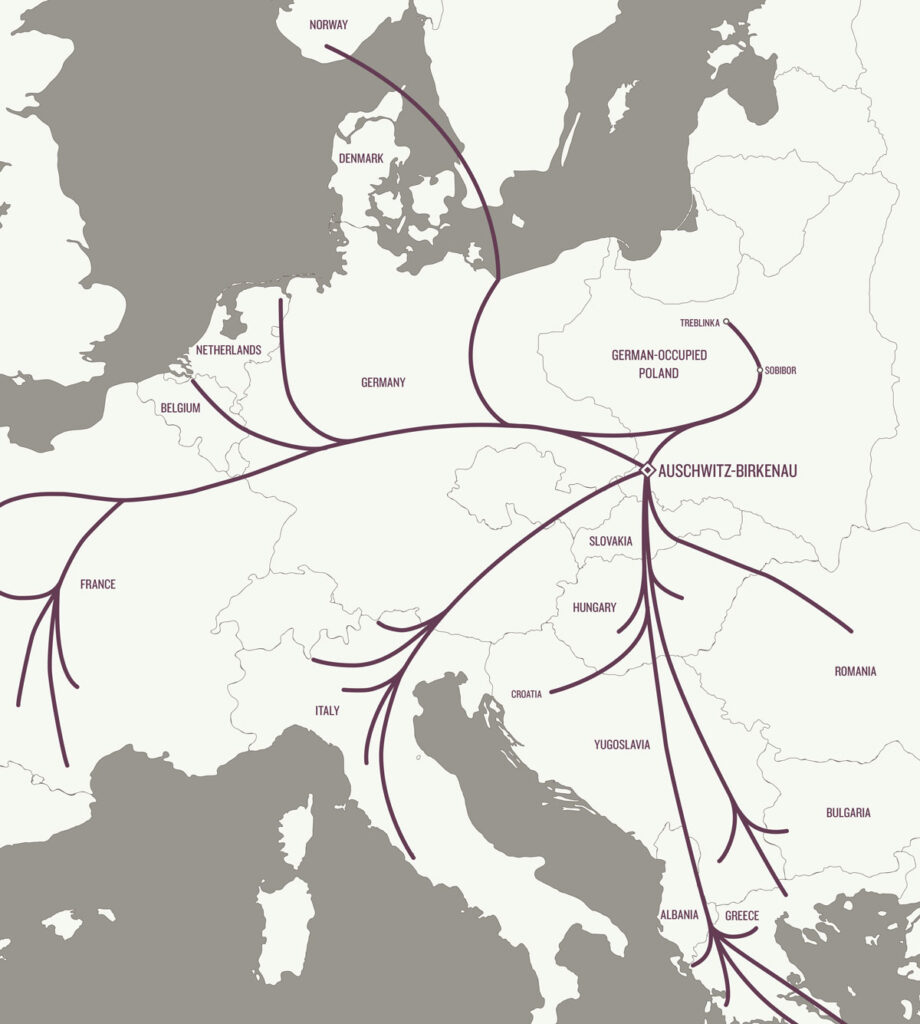
This map shows the railway routes used to deport Jews from across Europe to killing centers in German-occupied Poland from 1942 to 1944 (view larger map in a new tab).
Spring 1942
Death Penalty Is Introduced for Aiding Jews
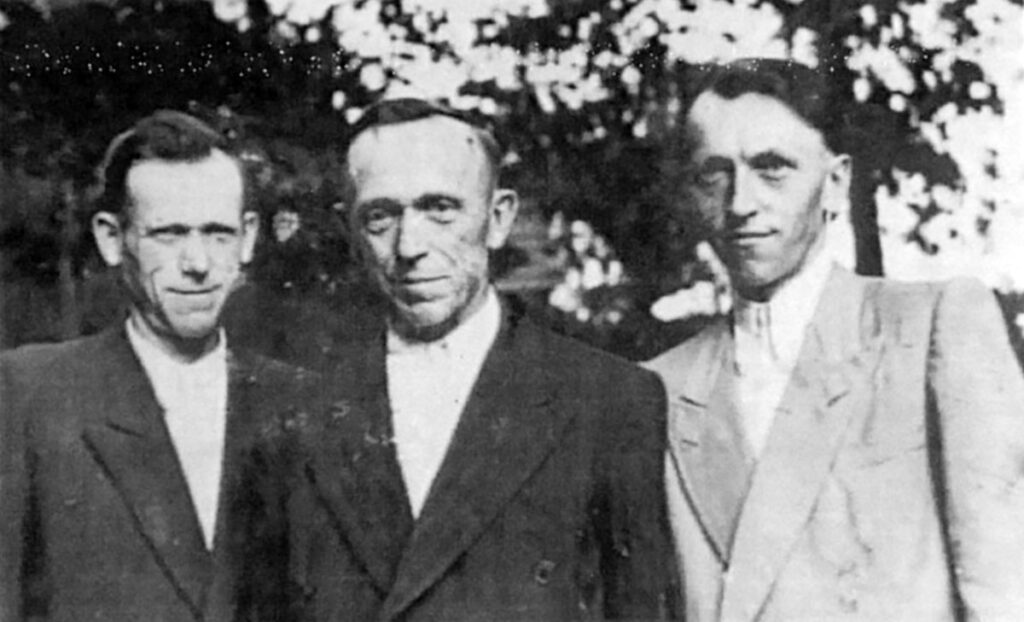
As part of a plan called “Operation Reinhard,” German authorities in occupied Poland began deporting Jews to Bełzec. Bełzec, Treblinka, and Sobibor were killing sites in occupied Poland used to murder Jews in large numbers with poison gas.
During “Operation Reinhard,” a young Polish man named Jan Kucharek found a job as a train driver transporting Jews to Treblinka. Jan claimed he did know what happened to the Jews after they were unloaded.
Leo Świerczek, (center, pictured with his sons) and Jack Pariser’s father, Abraham, did business together before the war, and the two families became trusted friends. Courtesy of Jack Pariser
As they started deporting Jews in Poland to killing centers, German authorities issued notices that anyone found to be hiding Jews faced severe penalties. Those caught were frequently punished with death.
Jack Pariser and his family were on the run from German authorities in Poland and on the verge of starvation. Despite the danger, an old friend offered them food and shelter when they needed it most.
Spring 1942
Jews Are Badged in Occupied Netherlands and France

False star worn by Maurice Lombart when he was arrested in Paris. Archives de la Préfecture de police, Paris
German officials in occupied Belgium, France, and Netherlands required that Jews ages six and over wear a yellow Star of David badge. The badges segregated Jews from the rest of the population, humiliated them, and made it easier for authorities to deport them.
In a sign of opposition to German rule, French teenagers made an unusual fashion statement to protest the badging of Jews in Paris in 1942.
November 19, 1942
Soviet Red Army Turns the Tide at Stalingrad

Assault units of the 62nd Soviet Army battle the Germans in Stalingrad. US Holocaust Memorial Museum, courtesy of National Archives and Records Administration
A Soviet counteroffensive resulted in a decisive victory over Germany and its Axis partners. After the Battle of Stalingrad, German forces began a long retreat to Berlin. Many Europeans began to realize that Nazi Germany would lose the war.
A resistance group of German students and their professor opposed the Nazi regime’s brutal occupation of the Soviet Union and campaign of mass murder against the Jews. They hoped that mounting German losses at Stalingrad would help convince other Germans to rebel against the Nazis.
April 19, 1943
Warsaw Ghetto Uprising Begins
German authorities deported around 280,000 Jews from the Warsaw ghetto in the summer of 1942. Against impossible odds, those remaining staged an uprising to resist further deportations. In putting down the uprising, German forces shot or deported some 49,000 of Warsaw’s Jews to camps.
September 8, 1943
Germany’s Axis Partner Italy Surrenders
Italian military losses and a lack of Italian public support for the war led Italy to surrender to the Allies. Germany quickly occupied Italy and began to deport the country’s Jews.
October 14, 1943
Sobibor Uprising Takes Place
Jewish prisoners forced to facilitate the killing process at Sobibor realized in 1943 that German authorities would close the site and murder them. They launched an uprising that killed a dozen guards. Of the 300 prisoners who escaped, only 58 survived the Holocaust.
March 19, 1944
German Forces Occupy Hungary
By 1943, leaders in Nazi-allied Hungary realized that Germany would lose the war. After they tried to negotiate a peace treaty with the Allies, German forces occupied the country.
May 15–July 9, 1944
Hungarian Jews Deported to Auschwitz
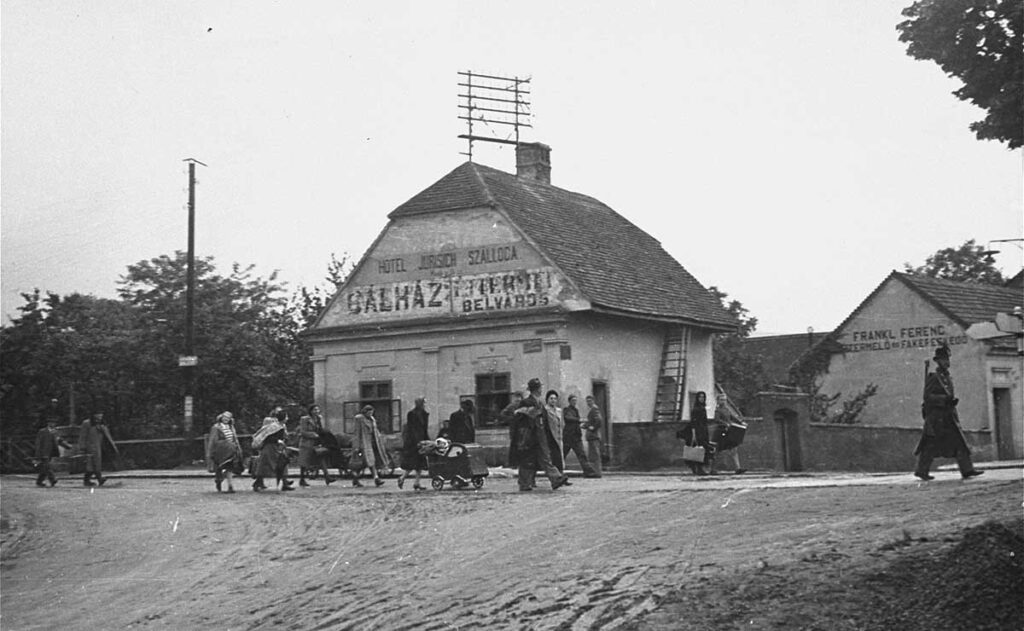
Hungarian gendarmes escort Jewish deportees to the Koszeg, Hungary, train station, where they will be boarded onto trains for Auschwitz. US Holocaust Memorial Museum, courtesy of Lydia Chagoll
By 1944, Hungary’s Jewish population of about 825,000 was the largest remaining in Europe. After the German occupation, Hungarian officials deported 425,000 Hungarian Jews to Auschwitz. In eight weeks, Nazi security forces murdered 330,000 in the gas chambers.
Steven Fenves was ten years old in 1944 when Hungarian officials deported his family to Auschwitz. As his family members were forced from their home, only the family’s cook took a brave step to help them.
June 6, 1944
D-Day Invasion Takes Place
British, American, and other Allied troops launched an invasion of France and soon advanced toward Berlin. Nazi Germany’s hold on Europe was severely weakened.
January 27, 1945
Soviet Soldiers Liberate Auschwitz
Soviet troops encountered thousands of dying prisoners left behind by Nazi authorities at Auschwitz. Soldiers also discovered thousands of shoes, watches, toothbrushes, and other items. Camp personnel took these belongings from many of Auschwitz’s 1.1 million victims.
May 7, 1945
Germany Surrenders, Ending the War in Europe

View of the bombed-out city of Nuremberg. US Holocaust Memorial Museum, courtesy of National Archives and Records Administration
Soviet forces encircled Berlin in April 1945, and Adolf Hitler committed suicide on April 30. Germany surrendered on May 7, 1945, ending the Holocaust and World War II in Europe. Germany and much of the continent lay in ruins.